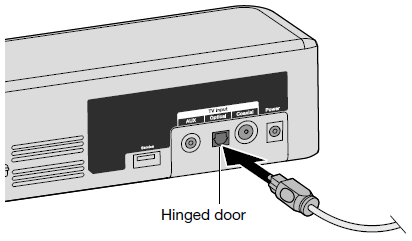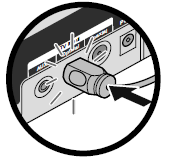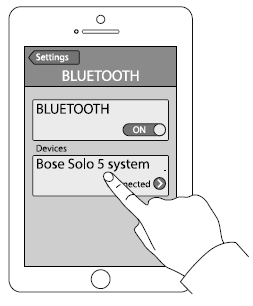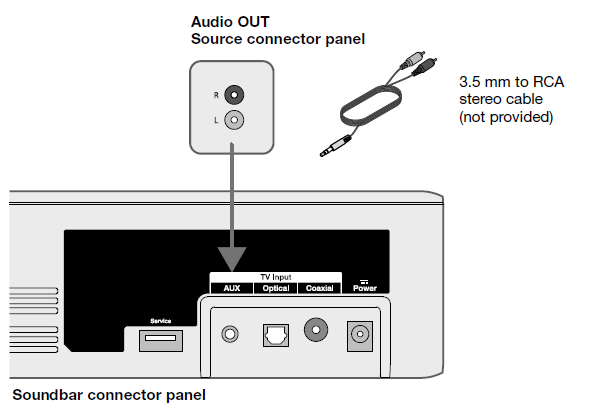
BOSE TV Speaker

Important Safety Instructions
Please read this owner’s guide carefully and save it for future reference.
The lightning flash with arrowhead symbol within an equilateral triangle alerts the user to the presence of uninsulated, dangerous voltage within the system enclosure that may be of sufficient magnitude to constitute a risk of electric shock
The exclamation point within an equilateral triangle, as marked on the system, is intended to alert the user to the presence of important operating and maintenance instructions in this owner’s guide.
WARNINGS:
- To reduce the risk of fire or electric shock, do not expose this product to rain or moisture.
- Do not expose this apparatus to dripping or splashing, and do not place objects filled with liquids, such as vases, on or near the apparatus. As with any electronic products, use care not to spill liquids into any part of the product. Exposure to liquids may create a failure and/ or fire hazard.
- Do not place naked flame sources, such as lighted candles, on or near the product.
- Replace only with a AA (IEC LR06) alkaline battery (or batteries).
CAUTION: Do not make unauthorized alterations to the product; doing so may compromise safety, regulatory compliance, system performance, and may void the warranty.
WARNING: This product contains magnetic material. Contact your physician if you have questions on whether this might affect the operation of your implantable medical device.
NOTES:
- Where the mains plug or appliance coupler is used as the disconnect device, such disconnect device shall remain readily operable.
- This product must be used indoors. It is neither designed nor tested for use outdoors, in recreational vehicles, or on boats.
- This product is intended to be used only with the power supply provided.
Bose Corporation hereby declares that this product is in compliance with the essential requirements and other relevant provisions of Directive 1999/5/EC and all other applicable EU directive requirements. The complete declaration of conformity can be found at: www.Bose.com/compliance
Please dispose of used batteries properly, following local regulations. Do not incinerate.
Important Safety Instructions
- Read these instructions.
- Keep these instructions.
- Heed all warnings.
- Follow all instructions.
- Do not use this apparatus near water.
- Clean only with a dry cloth.
- Do not block any ventilation openings. Install in accordance with the manufacturer’s instructions.
- Do not install near any heat sources, such as radiators, heat registers, stoves, or other apparatus (including amplifiers) that produce heat.
- Protect the power supply or cord from being walked on or pinched, particularly at plugs, convenience receptacles, and the point where they exit from the apparatus.
- Only use attachments/accessories specified by the manufacturer.
- Use only with the cart, stand, tripod, bracket, or table specified by the manufacturer, or sold with the apparatus. When a cart is used, use caution when moving the cart/ apparatus combination to avoid injury from tip-over.
- Unplug this apparatus during lightning storms or when unused for long periods of time.
- Refer all servicing to qualified service personnel. Servicing is required when the apparatus has been damaged in any way: such as power supply or cord is damaged; liquid has been spilled or objects have fallen into the apparatus; the apparatus has been exposed to rain or moisture, does not operate normally, or has been dropped.
This symbol means the product must not be discarded as household waste, and should be delivered to an appropriate collection facility for recycling. Proper disposal and recycling helps protect natural resources, human health and the environment. For more information on disposal and recycling of this product, contact your local municipality, disposal service, or the shop where you bought this product
Note: This equipment has been tested and found to comply with the limits for a Class B digital device, pursuant to Part 15 of the FCC Rules. These limits are designed to provide reasonable protection against harmful interference in a residential installation. This equipment generates, uses, and can radiate radio frequency energy and, if not installed and used in accordance with the instructions, may cause harmful interference to radio communications. However, there is no guarantee that interference will not occur in a particular installation. If this equipment does cause harmful interference to radio or television reception, which can be determined by turning the equipment off and on, the user is encouraged to try to correct the interference by one or more of the following measures:
- Reorient or relocate the receiving antenna.
- Increase the separation between the equipment and receiver.
- Connect the equipment into an outlet on a circuit different from that to which the receiver is connected.
- Consult the dealer or an experienced radio/TV technician for help.
Changes or modifications not expressly approved by Bose Corporation could void the user’s authority to operate this equipment.
This device complies with part 15 of the FCC Rules and Industry Canada license-exempt RSS standard(s). Operation is subject to the following two conditions:
- This device may not cause harmful interference, and
- This device must accept any interference received, including interference that may cause undesired operation.
This Class B digital apparatus complies with Canadian ICES-003. CAN ICES-3 (B) / NMB-3 (B)
This device complies with FCC and Industry Canada RF radiation exposure limits set forth for general population. It must not be co-located or be operating in conjunction with any other antennas or transmitters.
Radiation Exposure Statement: This equipment complies with FCC radiation exposure limits set forth for an uncontrolled environment. This equipment should be installed and operated with minimum distance 20cm between the radiator & your body.
Radiation Exposure Statement: This equipment complies with IC radiation exposure limits set forth for an uncontrolled environment. This equipment should be installed and operated with minimum distance 20cm between the radiator & your body.
Regulatory Information
|
Names and Contents of Toxic or Hazardous Substances or Elements |
||||||
|
Toxic or Hazardous Substances and Elements |
||||||
|
Part Name |
Lead (Pb) |
Mercury (Hg) |
Cadmium (Cd) |
Hexavalent (CR(VI) |
Polybrominated Biphenyl (PBB) |
Polybrominated diphenylether (PBDE) |
|
PCBs |
X |
O |
O |
O |
O |
O |
|
Metal parts |
X |
O |
O |
O |
O |
O |
|
Plastic parts |
O |
O |
O |
O |
O |
O |
|
Speakers |
X |
O |
O |
O |
O |
O |
|
Cables |
X |
O |
O |
O |
O |
O |
|
This table is prepared in accordance with the provisions of SJ/T 11364. O: Indicates that said hazardous substance contained in all of the homogeneous materials for this part is below the limit requirement of GB/T 26572. |
||||||
|
X: Indicates that said hazardous substance contained in at least one of the homogeneous materials used for this part is above the limit requirement of GB/T 26572. |
Please complete and retain for your records:Serial numbers can be found on the bottom of the soundbar and on the packaging for the remote control.Remote serial number: ________________________________________________________________Soundbar serial number: ______________________________________________________________Purchase date: _______________________________________________________________________We suggest you keep your receipt with this owner’s guide.
Date of manufacture: The four bolded digits in the serial number indicate the date of manufacture. The first digit is the year of manufacture; “5” is 2005 or 2015. Digits 2-4 are the month and date; “001” is January 1 and “365” is December 31.
China Importer: Bose Electronics (Shanghai) Company Limited, Part C, Plan 9, No. 353 North Riying Road, China (Shanghai) Pilot Free Trade Zone EU Importer: Bose GP, Castleblayney Road, Carrickmacross, Ireland
Taiwan Importer: Bose Taiwan Branch, Room 905, 9F, Worldwide House, 131 Min Sheng East Rd, Section 3, Taipei, Taiwan, 105
The Bluetooth® word mark and logos are registered trademarks owned by Bluetooth SIG, Inc. and any use of such marks by Bose Corporation is under license.
Blu-ray Disc™ and Blu-ray™ are trademarks of the Blu-ray Disc Association.

Manufactured under license from Dolby Laboratories. Dolby and the double-D symbol are trademarks of Dolby Laboratories.
The terms HDMI and HDMI High-Definition Multimedia Interface, and the HDMI Logo are trade- marks or registered trademarks of HDMI Licensing LLC in the United States and other countries.©2015 Bose Corporation. No part of this work may be reproduced, modified, distributed, or otherwise used without prior written permission.
Introduction
About your TV sound system
Your TV sound system provides clear, spacious sound from one compact sound bar.
System features
- Videostage® and TrueSpace® technologies deliver many of the benefits of a five-speaker home theater in a single sound bar.
- Sleek and elegantly designed sound bar fits easily in front of your TV.
- Connects with just one audio cable for easy setup.
- Programmable universal remote powers on/off your TV, cable/satellite box and system with the press of a single button.
- Stream music from Bluetooth® enabled devices.
- Stores up to eight Bluetooth enabled devices in its pairing list.
- Connects up to two Bluetooth enabled devices for easy switching between devices.
- Mounting ring to hide the power supply behind your mounted TV.
- Sound bar can be mounted on the wall (kit available separately).
Unpacking
Carefully unpack the carton and confirm that the following parts are included:
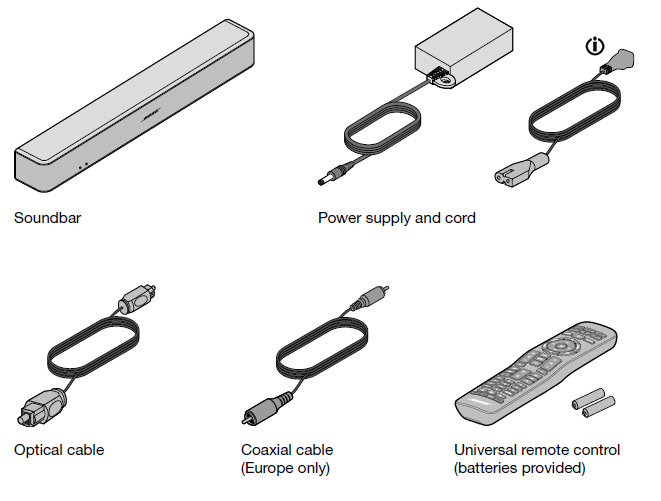
May ship with multiple power cords. The appropriate power cord for your region is supplied.
Note: If part of the system is damaged, do not use it. Contact your authorized Bose® dealer or Bose customer service. Refer to the contact sheet in the carton.
Placing the soundbar
- Stand the soundbar on its feet in front of your TV.
- Do not place your TV on the soundbar.
- Make sure there is an AC (mains) power outlet nearby.To avoid wireless interference:
- Keep other wireless equipment away from the soundbar.
- Place the soundbar outside of and away from metal cabinets, other audio/video components and direct heat sources.
Sample soundbar placement
Wall mounting the soundbar
You can mount the soundbar on a wall. To purchase the WB-120 Wall Mount Kit, contact your local Bose® dealer or visit www.Bose.comAfter wall mounting and setting up the soundbar, adjust the audio for better bass sound (see page 31).
CAUTION: Do not use any other hardware to mount the soundbar.
Setting Up the System
Cable options
Connect your TV to the soundbar using one of the two digital cable options.The optical cable is the preferred method for connection.
Note: If your TV does not have an optical or coaxial connector, see “Alternate Setup” on page 24.
- On the back of your TV, locate the Audio OUT (digital) connector panel.Note: You must connect the audio cable through your Audio OUT connector panel.
- Choose an audio cable.
Connecting your TV
Insert one end of the audio cable into the correct Audio OUT (digital) connector on your TV.
CAUTION: If using an optical cable, remove the protective caps from both ends. Inserting the plug in the wrong orientation can damage the plug and/or the connector.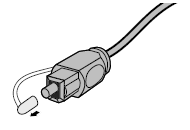
Connecting the soundbar
After connecting the audio cable to your TV, connect the other end to your soundbar. Use only one audio cable.For instructions on connecting a coaxial cable, see page 12.
Option 1: Optical cable (preferred)
CAUTION: Ensure you have removed the protective cap from both ends of the optical cable. Inserting the plug in the wrong orientation can damage the plug and/or the connector.
- Hold the optical cable’s plug with the Bose logo facing down.

- Align the plug with the Optical connector on the soundbar and insert the plug carefully.Note: The connector has a hinged door that swings inward when inserting the plug.
- Firmly push the plug into the connector until you hear or feel a click.

Option 2: Coaxial cable
Insert the other end of the coaxial cable into the Coaxial connector on the soundbar.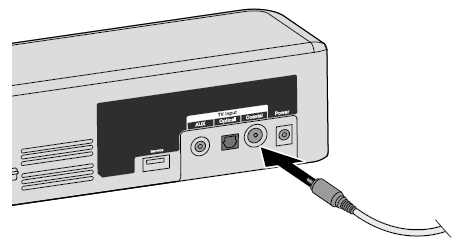
Connecting to power
- Plug the power supply into the Power connector.

- Plug one end of the power cord into the power supply.
- Plug the other end into a live AC power (mains) outlet. The soundbar emits a tone.
Mounting ring
To hide the power supply behind your mounted TV, use the mounting ring. Attach the mounting ring to your TV’s wall mount using zip ties or bread ties (not provided).
Turning off your TV speakers
To avoid hearing distorted sound, turn off your TV speakers.Refer to your TV’s owner’s guide for more information.
Powering on your soundbar
- Power on your TV.
- If you are using a cable/satellite box or other secondary source, power on the source.
- Press the Power button ( ) on the remote control.The status indicator glows green.

- Check if sound is coming from the soundbar.Note: If you do not hear sound coming from the soundbar, see “Troubleshooting” on page 30.
Confirming your TV speakers are off
- Press the Mute button ( ) on the remote control.
- Check that no sound is coming from your TV.Note: If you hear sound coming from your TV, see “Troubleshooting” on page 30.
Using the System
Use the remote to control sources connected to your system, adjust the system volume, change channels, use playback functions, enable cable/satellite box functions and navigate source menus.
Programming the universal remote
You can program the universal remote to control your source, such as a TV, DVD/ Blu-ray Disc™ player, cable/satellite box, game system or DVR, by entering the code for your source’s brand. There may be several codes for your source. You may need to perform this procedure multiple times to locate the correct code.
Locate your source’s code
- Power on your source.
- Locate the code for your source’s brand in the Universal Remote Device Codes book (provided).
Enter your source’s code
- On the remote control, press and hold the appropriate source button until all six source buttons glow, then release.For example, to program your TV, press and hold until all six source buttons glow, then release.The appropriate source button continues to glow.
- On the number keypad, enter the code for your source’s brand and press + on the volume button.
Test your source’s code
- Test your source for basic functions. Follow the instructions for your source:• TV: press the channel buttons. Press . The settings menu appears. Press and to navigate.• Cable/satellite box: press . The programming guide appears. Press and to navigate.• DVD or Blu-ray Disc™ player: press . The settings menu appears. Press and to navigate.• Game system: press and to navigate through your menu.
- Based on your source’s response to basic functions:• Remote responds accurately: press to exit programming and save your settings.• Remote does not respond or does not respond accurately:– If your source button glows: press + on the volume button to move to the next code. Repeat steps 1-2 in “Test your source’s code”. You may need to repeat this procedure 30 or more times. If all six buttons blink three times, you have cycled through all codes for your source.– If your source button is off: your remote exited programming mode. Repeat steps 1-2 in “Enter your source’s code” and steps 1-2 in “Test your source’s code”.
Tip: After you exit programming mode, press the appropriate source button to use your source.Note: Your source may not be compatible with universal remote controls. Refer to your source’s owner’s guide for more information.
You can customize (power button) on your remote to power on/off your soundbar, TV and cable/satellite box simultaneously.
- Program your remote to control your TV and cable/satellite box (see page 16).
- Press and simultaneously and hold for ten seconds. Both buttons flash three times.
Resyncing your cable/satellite box and TV
After customizing the power button, your cable/satellite box and TV may become out of sync and not power on/off simultaneously. Use the following steps to resync your soundbar.
- Press the source button for the source that is out of sync.
- Press to power on/off the source.
- Press Your sources power on/off simultaneously.
Switching between sources
You can switch from one source to another by pressing the appropriate source button on the remote.Note: Before you begin, ensure you have correctly programmed your sources.
- Press the button for the source you want to control. The source button glows.
- Press: The source powers on.
- Press and select the correct input on your TV.
The red, green, yellow and blue buttons on the remote control correspond with the color-coded function buttons on your cable/satellite box or teletext functions.
- Cable/satellite box functions: refer to your cable/satellite box’s owner’s guide.
- Teletext functions: correspond with color-coded page numbers, headings or shortcuts on a teletext display.
Adjusting the volume
On the remote control:
- Press to increase the volume.
- Press to decrease the volume.
- Press to mute or unmute the audio.Note: If you hear sound coming from your TV, see “Troubleshooting” on page 30.
Adjusting the bass level
- Press the Bass button ( ).The status indicator blinks white three times.
- On the remote control:
- Press to increase the bass.
- Press to decrease the bass.The status indicator blinks white three times and the soundbar saves your settings.
Note: For optimal sound quality for dialogue-only programs, such as news and talk shows, see page 19.
Resetting the bass level
On the remote control, press and hold for five seconds to reset the bass level to original factory settings.
Dialogue mode
Dialogue mode provides optimal sound quality for dialogue-only programs, such as news and talk shows, by decreasing the soundbar’s bass settings.Press the dialogue button ( ) to toggle between dialogue mode and your default audio settings.
The status indicator glows amber when dialogue mode is enabled.
Auto-wake
You can set the soundbar to power on whenever a sound signal is received.Note: The soundbar powers off after 60 minutes of inactivity. Press and hold on the remote for 5 seconds to toggle between auto-wake and default power settings.
The status indicator glows dim amber when the soundbar is off and auto-wake is enabled.
Programming a non-Bose remote control
You can program a non-Bose remote control, such as your cable/satellite box remote, to control the soundbar. Refer to your non-Bose remote control’s owner’s guide or cable/satellite website for instructions.Once programmed, the non-Bose remote performs basic functions such as power on/off and volume.
Bluetooth®
Pairing a Bluetooth® enabled device
Bluetooth® wireless technology enables you to stream music from Bluetooth enabled smartphones, tablets, computers or other audio devices to the soundbar.
Before you can stream music from a Bluetooth enabled device, you must pair your device with the soundbar.
- On the remote control, press and hold until the Bluetooth indicator blinks blue.Make sure the Bluetooth indicator blinks blue before you pair your device.
- On your Bluetooth enabled device, turn on the Bluetooth feature.Tip: The Bluetooth feature is usually found in Settings. A gear icon ( ) often represents Settings on the Home screen.

- Select Bose Solo 5 system from your device list.Once paired, the Bose Solo 5 system appears connected in the device list.
- On your Bluetooth enabled device, play music to stream to your soundbar.
If you cannot pair your deviceYou may need to clear the soundbar’s Bluetooth pairing list (see page 22). After you clear the list, try pairing again.See “Troubleshooting” on page 30 for more information.
Connecting to a paired Bluetooth® enabled device
You can stream audio from a Bluetooth® enabled device to the soundbar. There are two ways to stream audio from a paired device to the soundbar.If there are multiple devices stored in the soundbar’s pairing list, it may take a minute or two for the paired device to connect. The soundbar’s Bluetooth indicator shows connection status (see page 23).
- On the remote control, press .The soundbar connects to the last two devices that streamed to your soundbar.
- On your device, play music.If you cannot stream audio from a paired deviceThe soundbar may have lost connection to your device. Check the soundbar’s Bluetooth indicator. If the paired device is out of range of the soundbar, move your device within range.
Using the Bluetooth® feature on the paired device
- On your Bluetooth enabled device, turn on the Bluetooth feature.
- Select Bose Solo 5 system from the device list.
- Once connected, on your Bluetooth enabled device, play music to stream to the soundbar.
Switching between connected devices
The soundbar supports multi-point connectivity, which allows you to seamlessly switch playing music between connected devices.
The last two devices that streamed to the soundbar remain connected. During playback, you can pause audio on the streaming device, and then play music from another connected device.
- Pause music from the streaming device.
- On another connected device, play music.
- Repeat steps 1 and 2 to switch between connected devices.
Clearing the soundbar’s Bluetooth® pairing list
When you pair a Bluetooth® enabled device to the soundbar, the connection is stored in the soundbar’s pairing list. You may need to clear the pairing list if you cannot connect to a device. Once you clear the list, you need to pair previouslypaired devices again.
- Press and hold for ten seconds, until the Bluetooth indicator blinks blue.
- On your mobile device, delete Bose Solo 5 system from the Bluetooth menu.All paired mobile devices are cleared and the soundbar is ready to pair (see page 20).
Getting System Information
Soundbar indicators
The status and Bluetooth® indicators on the front of the soundbar provide information on soundbar activity.
Status indicator
|
Indicator activity |
System state |
|
Off |
Soundbar off (standby) |
|
Green |
Solid: Soundbar is on Blinking: Soundbar is muted |
|
Amber |
Dim: Standby, auto-wake is enabled Solid: Dialogue mode Blinking: Dialogue mode, soundbar is muted |
|
Red |
System error: Call Bose Customer Service. Refer to the contact sheet in the carton. |
Bluetooth® indicator
|
Indicator activity |
System state |
|
Blue |
Blinking: Ready to pair |
|
White |
Blinking: Connecting Solid: Connected |
Alternate Setup
You may need to use an alternate setup method for the following reasons:
- No sound from a source(s) connected to your TV.
- No optical or coaxial connector on your TV.
No sound from a source(s) connected to your TV
Some TVs do not deliver sound from connected sources to the soundbar. Use an alternate setup method to directly connect your source(s) to the soundbar.
|
Problem |
What to do |
|
No sound from a source connected to your TV |
Connect your source to the soundbar using one of the two cable options. (See page 25.) |
|
No sound from two sources connected to your TV |
Connect your sources to the soundbar using Option 1 or Option 2. (See page 27.) |
No optical or coaxial connector on your TV
Some TVs do not have optical or coaxial connectors. Use an alternate setup method to connect your TV to the soundbar.
|
Problem |
What to do |
|
TV only has an analog connector |
Connect your TV using a 3.5 mm to RCA stereo cable (not provided). (See page 26.) |
|
TV only has a headphones connector |
Connect your TV using a 3.5 mm stereo cable (not provided). (See page 29.) |
|
TV has no audio outputs |
Use the audio outputs on another source, such as a cable/satellite box to connect to the soundbar. (See page 25.) |
Connecting a source to the soundbar
If you do not get sound from a source, such as a DVD/Blu-ray Disc™ player, cable/satellite box, game system or DVR, connected to your TV, connect it to the soundbar. Use only one audio cable.CAUTION: If using an optical cable, remove the protective caps from both ends. Inserting the plug in the wrong orientation can damage the plug and/or the connector.
- On the back of your source, locate the Audio OUT (digital) connector panel.

- Choose an audio cable.
- If you have not already, disconnect your TV from the soundbar.
- Connect the audio cable from your cable/satellite box’s Audio OUT (digital) connector panel to the soundbar.Note: Do not disconnect your source’s video cable, such as an HDMI™ cable, from your TV.
Connecting a source’s analog connector to the soundbar
If your source does not have an optical or coaxial connector, and only has analog connectors (red and white), use a 3.5 mm to RCA stereo cable (not provided) to connect to the soundbar.
- If you have not already, disconnect your TV from the soundbar.
- Insert the RCA analog cable into the Audio OUT RCA (red and white) connectors on your source.
- Insert the stereo plug into the soundbar’s AUX connector.

Connecting two sources to the soundbar
If you do not get sound from any source, such as a DVD/Blu-ray Disc™ player, cable/satellite box, game system or DVR, connected to your TV, connect it to the soundbar. Use only one audio cable for each source.
- On the back of each source, locate the Audio OUT (digital) connector panel.
- Choose a separate audio cable for each source using either Option 1 or Option 2 (see page 28).Note: You MUST use either Option 1 or Option 2. Do not use the coaxial cable and optical cable at the same time.
- If you have not already, disconnect your TV from the soundbar.
- Separately connect the chosen audio cable from each source’s Audio OUT (digital) connector panel to the soundbar.Note: Do not disconnect your source’s video cable, such as an HDMI™ cable, from your TV.
Option 1This figure shows two source connections using an optical cable and 3.5 mm to RCA stereo cable (not provided).CAUTION: If using an optical cable, remove the protective caps from both ends. Inserting the plug in the wrong orientation can damage the plug and/or the connector.

Option 2This figure shows two source connections using a coaxial cable and 3.5 mm to RCA stereo cable (not provided).
Using two sources connected to the soundbarPower off sources when not in use. In order for one source to deliver audio to the soundbar, your other source must be off.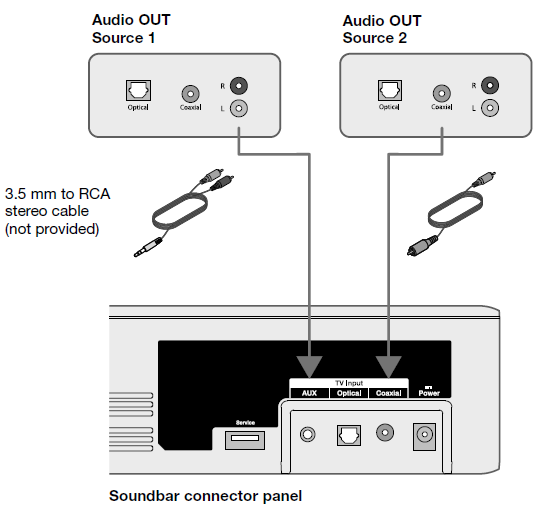
Connecting a TV headphones connector to the soundbar
If your TV only has a headphones connector, use a 3.5 mm stereo cable (not provided) to connect it to the soundbar.
- Insert the stereo plug into the TV headphones connector.
- Insert the other end of the cable into the AUX connector on your soundbar.
- Ensure your TV speakers are on. Refer to your TV’s owner’s guide for more information.
- To ensure optimal volume control from your soundbar,
- Set your TV’s volume to 75 percent of maximum.
- Next, set the volume level of your soundbar using the remote control.

Care and Maintenance
Troubleshooting
|
Problem |
What to do |
|
No power |
|
|
No sound |
|
|
Cannot play Bluetooth® |
|
|
Distorted sound |
|
|
Remote control is inconsistent or does not work |
|
|
Sound is coming from the TV |
|
|
Status indicator is red |
|
Adjusting the audio for wall mounting
- After wall mounting the soundbar, adjust the audio for better bass sound.
- Press and hold
 for 10 seconds.
for 10 seconds. - The soundbar emits a tone.
Tip: If you remove the soundbar from the wall, repeat to return the soundbar to default audio settings.
Replacing the remote batteries
Replace both batteries when the remote control stops operating or its range seems reduced. Use Alkaline batteries.
- Slide open the battery compartment cover on the back of the remote.
- Remove both batteries.
- Dispose of the batteries according to the regulations in your area.
- Insert two AA (IEC-LR6) 1.5V batteries or the equivalent. Match the + and – symbols on the batteries with the + and – markings inside the compartment.
- Slide the battery compartment cover back into place.

Cleaning
- Clean the surface of the system with a soft, dry cloth.
- Do not use any sprays near the system. Do not use any solvents, chemicals or cleaning solutions containing alcohol, ammonia or abrasives.
- Do not allow liquids to spill into any openings.
Customer service
For additional help, contact Bose Customer Service. Refer to the contact sheet in the carton.
Limited warranty
Your system is covered by a limited warranty. Details of the limited warranty are provided on the product registration card in the carton. Please refer to the product registration card for instructions on how to register. Failure to register will not affect your limited warranty rights.
The warranty information provided with this product does not apply in Australia or New Zealand. See our website at www.bose.com.au/warranty or www.bose.co.nz/warranty for details of the Australia and New Zealand warranty.
BOSE TV Speaker Owner’s Guide – BOSE TV Speaker Owner’s Guide –
[xyz-ips snippet=”download-snippet”]



